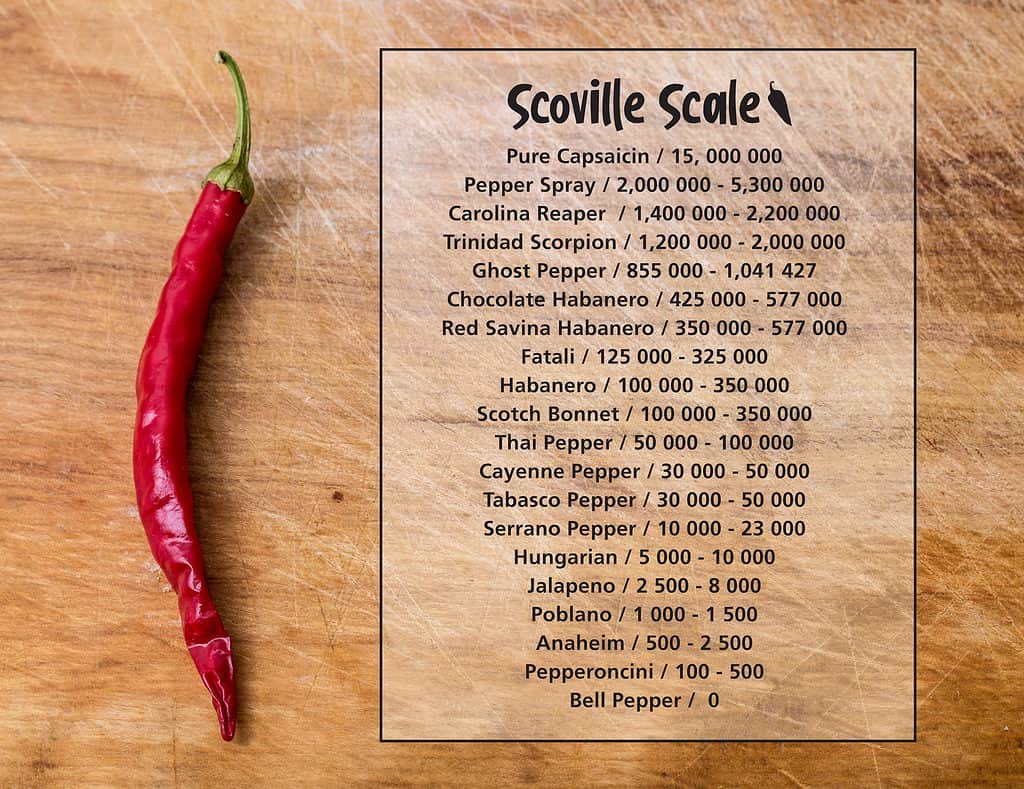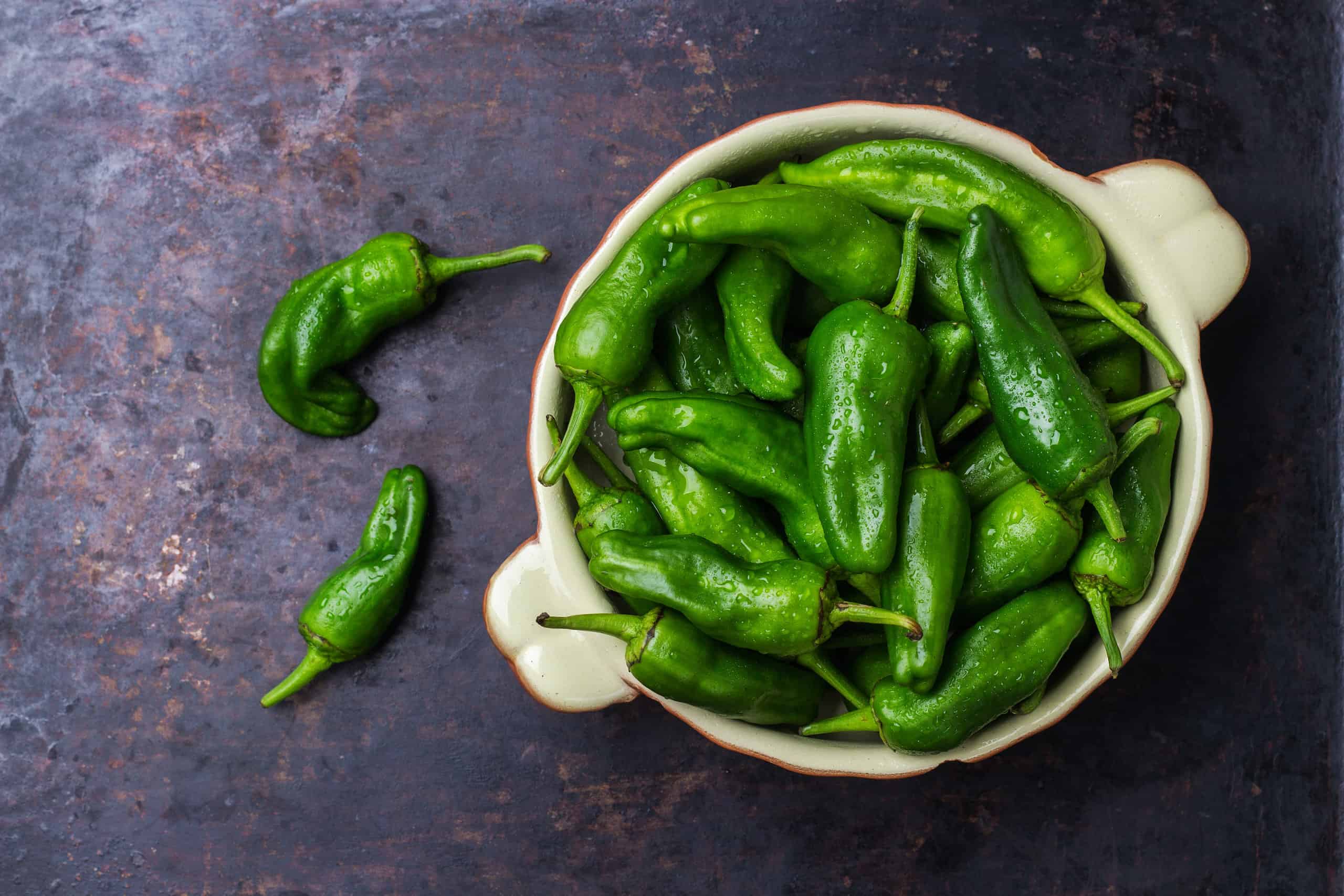Jalapeno peppers are a common ingredient in a wide variety of foods. You might throw jalapenos on your pizzas, in your fried rice, or you can even eat them solo, stuffed with delicious cream cheese!
There are a lot of ways to enjoy jalapenos. They bring just enough heat to a meal that you can enjoy all the flavors without being too overwhelmed with spice. But how hot are jalapeno peppers, really?
There’s only one way to find out, and that’s by taking a look at the Scoville scale. Measuring jalapeno peppers on the Scoville scale will give us the clearest understanding of how hot these delicious little peppers really are.
What is the Scoville scale?

The spicy part of the jalapeno is not the green area, but instead the fleshy center that is sometimes removed!
©iStock.com/hongquang09
The Scoville scale, in simple terms, is the way that scientists measure the pungency of a chili pepper. Pungency is the technical term for what we typically call heat or spice.
Chili peppers are a unique class of foods that possess capsaicinoids, which are the chemical components that make the peppers spicy. Just like we can measure the temperature of a food or the level of salt in a chip, it can be valuable to understand the pungency of a chili pepper. For one, it helps people decide which things are too spicy to be enjoyed!
Capsaicinoids are a general class of chemicals. In chili peppers, the most common capsaicinoid is capsaicin. Capsaicin is concentrated in the white flesh of a pepper and it’s what brings the heat to the flavor! It’s also an oil-like substance, which is why when we cut a jalapeno and then touch our eyes, it can really hurt.
Capsaicin produces spice when we eat it, but high concentrations of capsaicin can also burn to the touch. For example, ghost peppers, which are some of the spiciest peppers in the world, are generally cut while the preparer wears gloves. Isn’t it interesting that we eat something that we’re not willing to touch?
Who came up with the Scoville scale?
Wilbur Scoville created the Scoville scale at the beginning of the 20th century. Nowadays, the scale runs from 0 to 16 million, which is the spice level of pure capsaicin on its own.
When the Scoville scale was first created, it was a side effect of a test that Wilbur Scoville was doing with peppers. It was called the Scoville organoleptic test, and it was pretty simple. He’d bring in a group of people to eat peppers and then rank the peppers by spice. Because spice perception can be influenced by a lot of different factors, this was a bit subjective. However, the Scovill heat unit was born.
Nowadays, scientists use a chemical text called high-performance liquid chromatography to determine the amount of capsaicin present in a chili pepper. This results in a lot more precise, objective answer. The original test is rarely used, as scientists find the high-performance liquid chromatography test to be much stronger empirically.
How hot is a jalapeno?

The Carolina Reaper is the spiciest pepper in existence.
©julie deshaies/Shutterstock.com
Jalapenos feel very spicy to some and not spicy to others. How can that be? And how do we rank a pepper’s spiciness when people totally disagree?
That’s where the Scoville units come in!
Instead of asking individuals to rank the spiciness of a pepper, scientists can test jalapenos for their capsaicin content.
One thing that’s important to understand, however, is that peppers have a big range of possible Scoville units. Sometimes a jalapeno is somewhat spicy and on a different day, a different jalapeno could taste super spicy! Capsaicin concentration ranges not only from type of pepper to type of pepper but also between individual peppers. That’s why you never quite know what you’re going to get when you bring a pepper home.
Jalapenos rank fairly low on the full spread of the Scoville scale. Generally, a jalapeno is between 2,500 and 8,000 Scoville units (often close to 5,000). When comparing a jalapeno to a bell pepper, 5,000 units seems really hot! But when you compare a jalapeno to a habanero, for instance, a jalapeno pales in comparison.
How hot are other peppers?
Bell peppers are the lowest on the Scoville scale because, while they are a pepper, they have no capsaicin present. That’s why bell peppers aren’t spicy (despite being delicious).
Jalapenos rank fairly low on the Scoville scale, meaning there are quite a few peppers that are a lot hotter. Tabasco peppers are another common one, ranking 30,000-50,000 Scoville units. That means Tabasco peppers are often 10 times hotter than jalapenos!
It’s likely that you’ve had Tabasco sauce with your meal at some point. Tabasco is made with Tabasco peppers, but diluted with vinegar and salt. That means Tabasco sauce is actually less hot than the peppers themselves. Tabasco sauce is between 2,500 and 5,000 units, making it very comparable to the jalapeno.
Conclusion

Jalapeno peppers grow best in warm air with no frost.
©Quang Ho/Shutterstock.com
Conceptualizing spicy foods can be complicated. Using the Scoville scale, scientists were able to make sense of heat in peppers and food. Now that you know how spicy jalapeno is, you can decide whether you’re ready to cool it down with a bell pepper or up the anty and try a spicier chili!
Thank you for reading! Have some feedback for us? Contact the AZ Animals editorial team.








